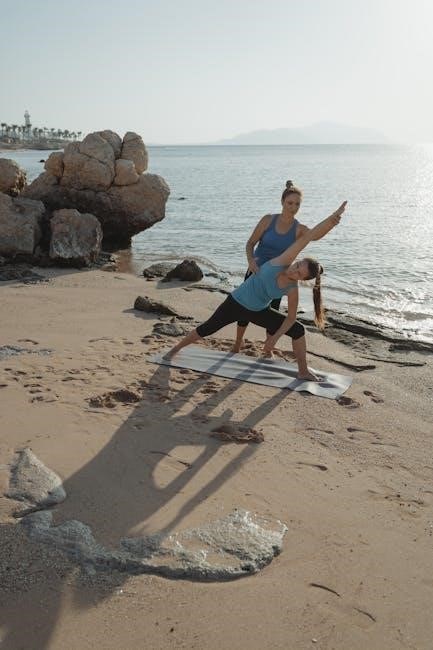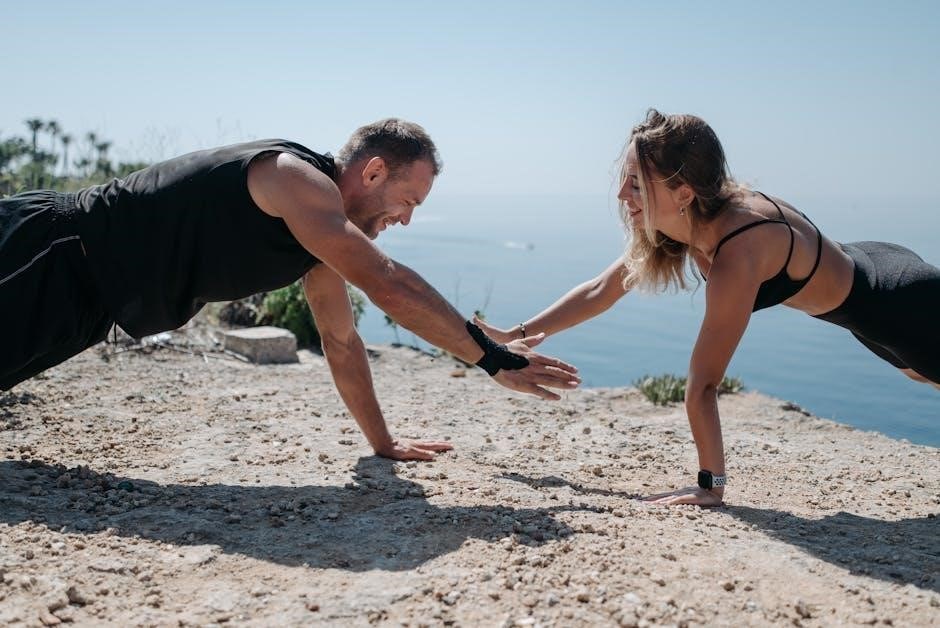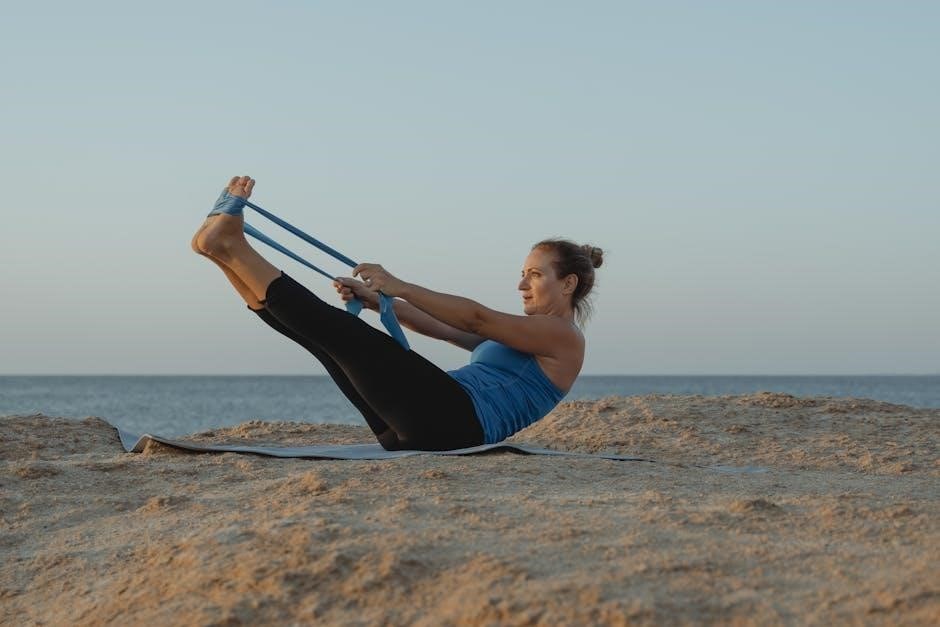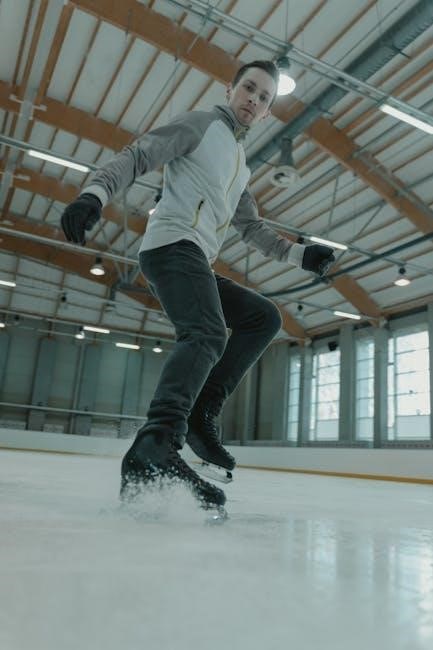Concussions, a form of mild traumatic brain injury, require tailored exercise programs for recovery. Aerobic, vestibular, and cognitive exercises promote healing, reducing symptoms and improving function, guided by sub-symptom thresholds and expert protocols like UPMC’s guidelines, ensuring safe progression and minimizing risks.
1.1 Understanding Concussion and Its Impact
A concussion is a mild traumatic brain injury caused by a blow to the head or body, leading to brain dysfunction. It impacts physical, cognitive, and vestibular functions, causing symptoms like dizziness, headaches, and memory issues. Understanding its effects is crucial for effective recovery, as prolonged symptoms can affect daily activities and overall well-being, emphasizing the need for tailored exercise programs.
1.2 Importance of Exercise in Concussion Recovery
Exercise plays a vital role in concussion recovery by improving physical, cognitive, and vestibular functions. Aerobic activities, such as cycling or swimming, enhance blood flow to the brain, aiding healing. Vestibular exercises reduce dizziness, while cognitive exercises restore mental clarity. A structured approach, adhering to sub-symptom thresholds, ensures safe progression, minimizing risks and accelerating return to normal activities and sports, supported by guidelines like those from UPMC Sports Medicine.
Types of Concussion Exercises
Concussion exercises include aerobic, vestibular, cognitive, and balance activities, each targeting specific recovery aspects, ensuring a comprehensive approach to healing and restoring function.
2.1 Aerobic Exercises
Aerobic exercises, like stationary biking and light swimming, are crucial for concussion recovery. These activities improve heart rate and blood flow without overexertion, promoting brain healing. They should be performed at a sub-symptom threshold, where the patient can breathe comfortably and maintain conversation. Progression is gradual, ensuring symptoms do not worsen, and is guided by medical protocols to enhance recovery safely and effectively.
2.2 Vestibular and Ocular Exercises
Vestibular and ocular exercises target balance and vision issues post-concussion. Activities include gaze stabilization, smooth pursuits, and head movements to improve coordination. These exercises enhance the brain’s ability to process visual and spatial information, reducing dizziness and improving focus. Supervised progression ensures safety and effectiveness, tailoring exercises to individual needs and symptom tolerance for optimal recovery outcomes.
2.3 Cognitive Exercises
Cognitive exercises aid in restoring mental functions impaired by concussions, such as memory, attention, and processing speed. Activities include memory games, puzzles, and mindfulness practices, promoting neural recovery. These exercises are tailored to individual progress, ensuring gradual improvement without overexertion. Supervised programs and structured routines help maximize cognitive recovery, enabling a smoother return to daily activities and mental tasks.
2.4 Balance and Coordination Exercises
Balance and coordination exercises focus on restoring vestibular function and motor skills after a concussion. Activities like single-leg stands, heel-to-toe walking, and Romberg tests improve stability. Swiss ball exercises and tandem walking enhance proprioception and posture. These exercises reduce dizziness and risk of falls, promoting safe and effective recovery. Tailored programs ensure progression at a comfortable pace, supervised to prevent overexertion and maximize benefits.

Guidelines for Concussion Exercise Programs
Exercise programs for concussion recovery must be tailored to individual tolerance, focusing on sub-symptom threshold training. Activities are gradually increased to avoid worsening symptoms, ensuring a safe progression.
3.1 Sub-Symptom Threshold Training
Sub-symptom threshold training involves exercises performed at an intensity below the level that triggers symptoms. Activities like light swimming, stationary biking, or resistive bands are recommended. This approach prevents overexertion, allowing gradual progression without exacerbating symptoms. Monitoring symptoms during and after exercise is crucial to ensure safety and effectiveness, promoting a controlled recovery process tailored to individual tolerance levels and needs.
3.2 Progressive Exercise Progression
Progressive exercise progression involves gradually increasing the intensity of physical activities as concussion symptoms improve. Tailored to individual recovery, it starts with light exercises like brisk walking or swimming. As tolerance grows, resistance training or dynamic balance exercises are introduced. This structured approach ensures steady improvement without overexertion, adhering to medical guidelines to promote safe and effective recovery.
3.3 Monitoring Symptoms During Exercise
Monitoring symptoms during exercise is crucial for safe concussion recovery. Patients should report any dizziness, headaches, or fatigue. Exercises are adjusted to stay below symptom thresholds, ensuring activities remain tolerable. Regular assessments help prevent overexertion, guiding gradual progression. This vigilant approach minimizes risks, promoting a balanced and effective rehabilitation process tailored to individual needs and recovery pace.
Stage-Based Rehabilitation Programs
Stage-based rehabilitation programs offer a structured approach to concussion recovery, progressing from rest to advanced training. Each stage is tailored to individual recovery, ensuring safety and effectiveness.
4.1 Stage 1: Initial Rest and Symptom Management
Stage 1 focuses on complete rest to reduce brain strain. Activities are minimized to avoid worsening symptoms like headaches or dizziness. Cognitive rest, limited screen time, and avoiding physical exertion are crucial. Patients should monitor symptoms closely and avoid any tasks that exacerbate discomfort. This period is essential for allowing the brain to heal naturally without interference.
4.2 Stage 2: Light Physical Activity
Stage 2 introduces low-intensity exercises like stationary biking, light swimming, or resistive band workouts. These activities are symptom-limited, ensuring no worsening of symptoms. Patients gradually increase physical exertion while monitoring their tolerance. This phase aims to restore basic physical function without overexertion, preparing for more advanced movements in later stages under professional guidance.
4.3 Stage 3: Moderate Exercise and Functional Movements
Stage 3 involves moderate-intensity exercises, such as single-leg balance drills, Swiss ball workouts, and dynamic movements like walking heel-to-toe. Functional activities mimic daily tasks or sports-specific actions, enhancing coordination and strength. Exercises are tailored to improve balance, stability, and overall physical function, preparing the individual for more demanding activities while maintaining symptom control under professional supervision.
4.4 Stage 4: Advanced Training and Return to Play
Stage 4 focuses on high-intensity aerobic workouts, sport-specific drills, and complex functional movements. Activities include advanced balance exercises, agility training, and full-speed drills mimicking real-game scenarios. Medical clearance is required before progression. Symptom monitoring continues to prevent relapse. This phase ensures the individual is physically and cognitively ready for unrestricted participation, following a stepwise return-to-play protocol to minimize risk of re-injury.

Specific Exercises for Concussion Recovery
Specific exercises for concussion recovery include Marching Zombie Stand, Smooth Pursuits, Peripheral Awareness, and Gaze Stabilization. These activities target physical and cognitive functions, detailed in concussion exercises PDF guides.
5.1 Marching Zombie Stand
Stand with feet shoulder-width apart, arms elevated at 90 degrees, fingers pointed downward. March in place while rotating your head side to side for 60 seconds per side. Keep arms straight and maintain finger alignment. This exercise improves balance, coordination, and reduces dizziness. Perform 2-3 sets, as tolerated, to enhance vestibular stability and overall recovery progress, as detailed in concussion exercises PDF guides.
5.2 Smooth Pursuits and Eye Movements
Focus on a stationary object and slowly move your eyes between near and far targets without head movement. This exercise enhances ocular coordination, reducing dizziness and improving focus. Perform smooth pursuits horizontally and vertically for 1-2 minutes, 2-3 times daily. Gradually increase complexity to improve visual stability and reduce symptoms, as outlined in concussion exercises PDF resources for recovery.
5.3 Peripheral Awareness Exercises
Stare at a blank wall or distant object. Hold this gaze while throwing a soft ball straight up and catching it with the same hand. Repeat on the other side. Perform 3 sets of 10 repetitions. These exercises enhance visual field awareness without head movement, improving balance and coordination. Detailed instructions are available in concussion exercises PDF guides for tailored recovery plans.
5.4 Gaze Stabilization Exercises
Focus on stationary targets while moving your head side-to-side or up-and-down slowly. Hold focus for 10 seconds, then shift gaze to another target. Repeat for 2-3 minutes, 2-3 times daily. These exercises improve eye-head coordination and reduce dizziness. Detailed instructions and variations are outlined in concussion exercises PDFs, aiding in personalized rehabilitation plans and enhancing visual stability during recovery.

Safety Considerations and Precautions
Avoid overexertion and monitor symptoms during exercises. Use proper breathing techniques and protective gear when necessary. Gradually increase activity levels to prevent setbacks and ensure safe recovery.
6.1 Avoiding Overexertion
Avoiding overexertion is crucial in concussion recovery. Exercises should be performed at a sub-symptom threshold, meaning activities should not worsen symptoms like dizziness or headaches. Gradual progression ensures the brain heals without additional stress. Monitoring symptoms during and after exercise helps prevent setbacks, promoting a safer and more effective recovery process. Always consult healthcare professionals to tailor exercises appropriately.
6.2 Proper Breathing Techniques
Proper breathing techniques are essential for managing concussion symptoms and promoting recovery. Deep, controlled breathing helps stabilize the autonomic nervous system, reducing dizziness and headaches. Techniques include diaphragmatic breathing, where the abdomen rises with each inhale, and box breathing, involving equal durations of inhalation, hold, exhalation, and rest. These methods enhance oxygen flow and reduce stress, aiding in symptom relief and overall recovery.
6.3 Use of Protective Gear
Protective gear is crucial during concussion recovery exercises to prevent further injury. Helmets, mouthguards, and padded equipment should be worn, especially in activities involving contact or falls. Proper fitting ensures effectiveness, minimizing risk factors. This precautionary measure is vital for athletes returning to play, safeguarding against secondary concussions and promoting a safer rehabilitation environment.

Cognitive Rest and Activity Management
Cognitive rest involves limiting mentally demanding tasks and screen time to reduce brain strain. Activities should be gradually reintroduced, ensuring symptoms do not worsen. Mindfulness exercises and structured plans help manage recovery effectively, promoting mental clarity and stability during the healing process.
7.1 Limiting Screen Time
Limiting screen time is crucial during concussion recovery to avoid exacerbating symptoms like headaches and eye strain. Reduce exposure to digital devices, including phones, computers, and TVs, as they can overstimulate the brain. Set time limits and prioritize restful activities. Use blue light filters or adjust screen settings to minimize eye discomfort. Gradually reintroduce screen time as symptoms improve, ensuring activities remain tolerable and recovery progresses smoothly.
7.2 Mindfulness-Based Exercises
Mindfulness practices, such as meditation and deep breathing, aid in managing concussion symptoms by reducing stress and promoting relaxation. These exercises help regulate the body’s autonomous systems, which can be disrupted post-concussion. Regular mindfulness sessions improve focus and emotional well-being, complementing physical recovery. They are often recommended alongside other therapies to enhance overall healing and provide mental clarity during the rehabilitation process.
7.4 Gradual Return to Cognitive Tasks
A gradual return to cognitive tasks is essential for concussion recovery. Start with light activities like reading or puzzles, progressing slowly to more complex tasks. Monitor symptoms and adjust activities accordingly. Structured plans help rebuild mental stamina without overexertion. Supervised by healthcare providers, this approach ensures a safe transition to normal cognitive function, minimizing setbacks and promoting long-term recovery. Proper pacing is key to avoiding prolonged symptoms and achieving full mental clarity.

Role of Physical Therapy in Concussion Recovery
Physical therapy plays a crucial role in concussion recovery by providing customized exercise plans, supervised rehabilitation, and utilizing equipment like Swiss balls to enhance strength and balance safely.
8.1 Customized Exercise Plans
Customized exercise plans are tailored to individual needs, focusing on sub-symptom threshold training. They include aerobic activities like cycling, balance exercises such as single-leg stands, and vestibular drills to address dizziness. These plans are adjusted based on symptom response, ensuring gradual progression without overexertion. The goal is to restore functional movements and prepare for daily activities or sports safely and effectively.
8.2 Supervised Rehabilitation Sessions
Supervised rehabilitation sessions involve close monitoring by physical therapists to ensure safe and effective recovery. These sessions incorporate exercises like marching zombie stands, balance drills, and vestibular training. Professionals adjust activities based on symptom tolerance, focusing on gradual progression. Use of equipment, such as Swiss balls for core stability, enhances functional movements. The structured approach minimizes risks and accelerates recovery, tailored to individual goals and medical guidelines.
8.3 Use of Equipment Like Swiss Balls
Swiss balls are versatile tools in concussion rehabilitation, enhancing core stability and balance. Patients perform seated balance exercises, wall push-ups, or gentle stretches using the ball. These activities improve strength and coordination without overexertion. Supervised sessions ensure proper form, tailoring exercises to individual tolerance and progression, promoting safe and effective recovery from concussion symptoms.
Return-to-Play Protocols
Return-to-play protocols ensure athletes gradually resume activities post-concussion, following stepwise progression and medical clearance. Light jogging or cycling starts at sub-symptom thresholds, with monitoring for symptom recurrence.
9.1 Stepwise Progression
Stepwise progression ensures athletes gradually return to play post-concussion, starting with light activities like jogging or cycling at sub-symptom thresholds. Each stage must be symptom-free before advancing. Sport-specific drills follow, emphasizing balance and coordination. Medical clearance is required before full return. Progression is tailored to individual tolerance, avoiding overexertion and ensuring safe reintegration into competitive environments.
9.2 Medical Clearance and Assessment
Medical clearance is crucial before returning to play, involving a thorough assessment of symptoms, cognitive function, and physical abilities. Physicians use standardized tools like balance tests and neurocognitive evaluations to ensure full recovery. Clearance confirms the athlete’s readiness for unrestricted participation, minimizing recurrence risks. Proper documentation and communication with coaches and parents are essential to safeguard the athlete’s health and well-being.
9.3 Communication Between Stakeholders
Effective communication among athletes, coaches, parents, and healthcare providers ensures a safe return-to-play process. Sharing recovery progress, test results, and any lingering symptoms fosters trust and alignment. Regular updates and open dialogue help prevent premature return and reduce risks of further injury. Clear, consistent communication is vital for supporting the athlete’s health and facilitating a smooth transition back to activity.
Resources and PDF Guides
Valuable resources include UPMC Sports Medicine Guidelines, CDC Recommendations, and Printable Exercise Sheets, offering detailed concussion recovery exercises, protocols, and tips for safe rehabilitation and monitoring.
10.1 UPMC Sports Medicine Guidelines
The UPMC Sports Medicine Guidelines provide comprehensive concussion recovery strategies, emphasizing sub-symptom threshold exercises and stage-based rehabilitation. Their protocols include aerobic activities like stationary biking, resistive bands, and balance exercises. These guidelines stress monitoring symptoms and gradual progression to ensure safe recovery. They are widely recognized for their evidence-based approach, helping patients return to daily activities and sports effectively.
10.2 CDC Recommendations for Concussion Recovery
The CDC emphasizes rest and symptom management as foundational for concussion recovery. They recommend gradual resumption of activities, avoiding those that worsen symptoms. The guidelines stress the importance of monitoring progress and seeking medical clearance before returning to play or work. The CDC also provides resources for creating personalized recovery plans to minimize long-term effects and ensure a safe return to normal activities.
10.3 Printable Exercise Sheets
Printable exercise sheets provide structured concussion recovery plans, including aerobic, vestibular, and cognitive exercises. They often feature illustrated guides for movements like the “Marching Zombie Stand” and “Smooth Pursuits.” These sheets are customizable, allowing patients to track progress and symptoms. Many resources, such as the UPMC guidelines and CDC recommendations, offer downloadable PDFs to support home-based rehabilitation, ensuring consistency and safety in the recovery process.